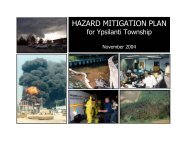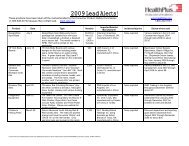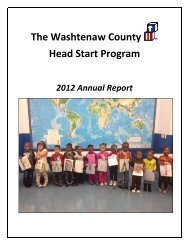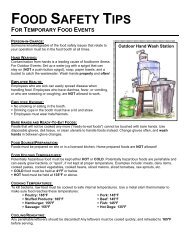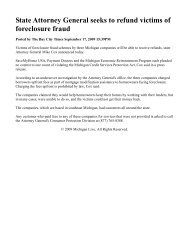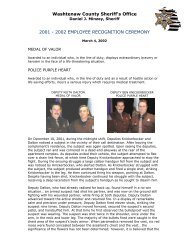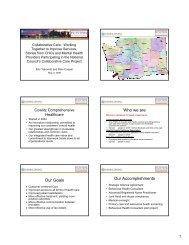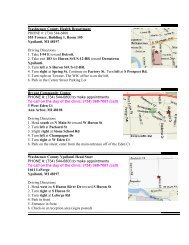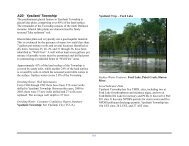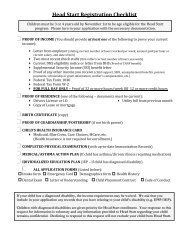Water Protection Activities in Washtenaw County
Water Protection Activities in Washtenaw County
Water Protection Activities in Washtenaw County
Create successful ePaper yourself
Turn your PDF publications into a flip-book with our unique Google optimized e-Paper software.
Challenge #9 Excess Nutrients<br />
It is natural for nutrients to be present <strong>in</strong> the water column or <strong>in</strong><br />
bottom sediments of our rivers, lakes and streams. Michigan’s<br />
limestone rich soils are a natural source of calcium and<br />
phosphorus, and decay<strong>in</strong>g plants and animals provide other<br />
nutrients such as nitrogen and potassium. Nutrients are the<br />
build<strong>in</strong>g blocks for all plant and animal life <strong>in</strong> the aquatic<br />
environment.<br />
Human activity can<br />
cause over-nutrification<br />
and affect water<br />
quality, especially <strong>in</strong><br />
slow mov<strong>in</strong>g or<br />
stagnant water. A<br />
nutrient-rich lake can<br />
often be subject to<br />
frequent and severe<br />
What protection activities<br />
address the challenge of<br />
excess nutrients?<br />
Clean <strong>Water</strong> Act<br />
Michigan Dra<strong>in</strong> Code<br />
<strong>Water</strong>shed Management Plans<br />
Illicit Discharge Elim<strong>in</strong>ation<br />
NREPA<br />
nuisance algal blooms, low transparency and hypoxia (low<br />
oxygen). Lakes with very high nutrient concentrations and<br />
biological activity are termed hypereutrophic. Some causes of<br />
high nutrient concentrations are:<br />
● Pav<strong>in</strong>g over land (prevents <strong>in</strong>filtration and causes<br />
erosion)<br />
● Construction site erosion<br />
● Excessive or <strong>in</strong>appropriate fertilization<br />
● Improper manure management<br />
● Septic system failures<br />
● Pet waste and urban wildlife<br />
● Sanitary sewer overflows<br />
Nutrient Response Objective<br />
Limit nutrient delivery to waterways from stormwater runoff,<br />
agricultural activities, and sanitary overflows.<br />
46<br />
Nutrient Response Results<br />
Nutrients are often bound <strong>in</strong> sediments. As a result, the erosion<br />
control regulations mentioned <strong>in</strong> the ‘Sediments’ discussion<br />
(Challenge #10) apply to nutrients. Both the Federal Clean<br />
<strong>Water</strong> Act NPDES program and the Michigan Natural<br />
Resource Environmental <strong>Protection</strong> Act (NREPA) regulate<br />
activities that disturb more than one acre of land, or any<br />
acreage with<strong>in</strong> 500 feet of a waterway.<br />
Figure 9: Storm <strong>Water</strong> Runoff<br />
Source: <strong>County</strong> Dra<strong>in</strong> Commissioners Office, December 2005<br />
These same laws require primary and secondary treatment of<br />
wastewater before be<strong>in</strong>g discharged to rivers, lakes or streams.<br />
Septic systems are regulated under NREPA and <strong>County</strong> codes.<br />
A Total Maximum Daily Load (TMDL) has been established<br />
for phosphorus for the middle Huron River. A TMDL is a<br />
pollutant budget that limits the amount of phosphorus that can<br />
be delivered to the river by human activity. S<strong>in</strong>ce 1994,<br />
the Huron River <strong>Water</strong>shed Council has managed the<br />
17-community “Middle Huron River <strong>Water</strong>shed Initiative”, a<br />
comprehensive strategy to meet the Phosphorus TMDL.



